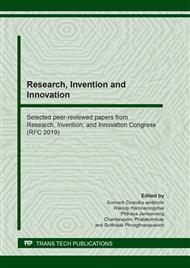[1]
H. J. T. Ellingham, Reducibility of oxides and sulphides in metallurgical processes, J. Soc. Chem. Ind. 63 (1944) 125–133.
Google Scholar
[2]
S. W. Mayer, B. B. Owens, T. H. Rutherford, R. B. Serrins, High-temperature free energy, entropy, enthalpy and heat capacity of thorium sulfate, J. Phys. Chem. 64 (1960) 911–914.
DOI: 10.1021/j100836a024
Google Scholar
[3]
M. Cavallini, Thermodynamics applied to iron smelting techniques, Appl. Phys. A. 113 (2013) 1049–1053.
DOI: 10.1007/s00339-013-7746-8
Google Scholar
[4]
P. Sarrazin, A. Galerie, J. Fouletier, Mechanisms of High Temperature Corrosion: A Kinetic Approach, Trans Tech Publications, Switzerland, (2008).
Google Scholar
[5]
S. Chandra-ambhorn, T. Nilsonthi, Y. Wouters, A. Galerie, Oxidation of simulated recycled steels with 0.23 and 1.03 wt.% Si in Ar-20% H2O at 900 ºC, Corros. Sci. 87 (2014) 101–110.
DOI: 10.1016/j.corsci.2014.06.018
Google Scholar
[6]
S. Chandra-ambhorn, T. Phadungwong, K. Sirivedin, Effects of carbon and coiling temperature on the adhesion of thermal oxide scales to hot-rolled carbon steels, Corros. Sci. 115 (2017) 30–40.
DOI: 10.1016/j.corsci.2016.11.014
Google Scholar
[7]
S. Chandra-ambhorn, A. Jutilarptavorn, T. Rojhirunsakool, High temperature oxidation of irons without and with 0.06 wt.% Sn in dry and humidified oxygen, Corros. Sci. 148 (2019) 355–365.
DOI: 10.1016/j.corsci.2018.12.030
Google Scholar
[8]
S. Chandra-ambhorn, Y. Wouters, L. Antoni, F. Toscan, A. Galerie, Adhesion of oxide scales grown on ferritic stainless steels in solid oxide fuel cells temperature and atmosphere conditions, J. Power Sources 171 (2007) 688–695.
DOI: 10.1016/j.jpowsour.2007.06.058
Google Scholar
[9]
S. Chandra-ambhorn, P. Saranyachot, T. Thublaor, High temperature oxidation behaviour of Fe–15.7 wt.% Cr–8.5 wt.% Mn in oxygen without and with water vapour at 700 ºC, Corros. Sci. 148 (2019) 39–47.
DOI: 10.1016/j.corsci.2018.11.023
Google Scholar
[10]
S.Chandra-ambhorn, P.Chumpanya, High temperature oxidation behaviour of Ag–36.35 wt.% Zn and Ag–38.50 wt.% Zn–0.60 wt.% Al, Corros. Sci. 131 (2018) 38–44.
DOI: 10.1016/j.corsci.2017.11.007
Google Scholar
[11]
A. Ghosh, Textbook of Materials and Metallurgical Thermodynamics, Prentice-Hall of India, India, (2003).
Google Scholar
[12]
S. Chandra-ambhorn, Advanced Thermodynamics of Materials, KMUTNB textbook publisher, Thailand, (2016).
Google Scholar
[13]
O. Kubaschewski, C.B. Alcock, P.J. Spencer, Materials Thermochemistry, sixth ed., Pergamon, England, (1993).
Google Scholar
[14]
D. R. Gaskell, Introduction to the Thermodynamics of Materials, Fifth ed., CRC Press, England, (2008).
Google Scholar


